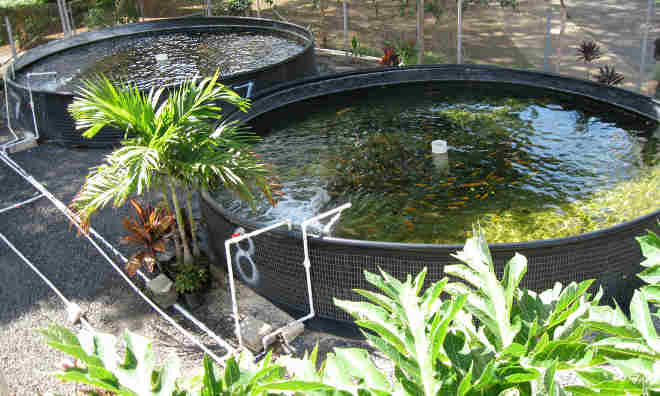The New York Times recently reported that the number of farm-raised fish consumed by people across the world will exceed that of wild-caught fish this year. This is the first time in human history that aquaculture will become more prevalent than commercial fishing.
There are multiple forms of aquaculture, but the two basic models are cage systems and irrigation, or pond, systems. In cage systems, large enclosed areas are placed in a body of water – which could be anything from a bayou to open ocean – and fish are raised within them while subsisting on a diet of fish feed. In irrigation/pond systems, fish are cultivated in artificial ponds – even large tanks – which are regularly irrigated to help prevent disease and water contamination. In a method pioneered by the New Alchemy Institute, fishponds or tanks are connected to aquaponic plant beds. Irrigated water from the ponds, including waste from the fish, is used to nourish the plants. This method has been put into practice with varying degrees of success, but one notable example can be found in The Plant, a vertically integrated urban farm in Chicago.
Aquaculture is often cited as a hugely efficient form of food production due to the fact that the feed-conversion ratio of farmed fish is nearly 1:1 for some species. This means that for every weight-unit of nourishment provided, almost the same weight-unit of fish is produced. But aquaculture methods have not yet been perfected and still present significant environmental problems, such as the spread of disease in farmed fish populations to wild fish populations and the subsequent overuse of antibiotics and chemicals to control these outbreaks. Waste from pond and cage fisheries can also contribute to water pollution and oxygen depletion in neighboring, non-farm bodies of water.
A major contributing factor to the exponential growth of fisheries is that human consumption of seafood has nearly doubled in the past fifty years. According to the United Nations’ Food and Agriculture Organization’s 2012 State of World Fisheries and Agriculture Report, estimated global per capita fish consumption in 2010 was, on average, 41 pounds (18.6 kilograms), compared with the global per capita average of 21.8 pounds (9.9 kilograms) in the 1960’s. The foremost increases in consumption are in East Asia – China, in particular, has seen the largest increases in both fish consumption and production. A full third of global fish production is now Chinese, largely due to aquaculture.
In light of the rapidly growing fish consumption, aquaculture has the potential to increase incomes, reduce malnutrition, and protect wild fish populations in developing regions. For example, British organization Action Against Hunger has undertaken an initiative to protect food security and treat malnutrition in the Democratic Republic of Congo. In addition to agricultural and technical training, Action Against Hunger has supported the implementation of pond-system fish farms, as pictured above, in the community of Masi Manimba. While these fisheries currently serve only in the capacity of subsistence farming, they have the potential to operate as a source of income for the community.















